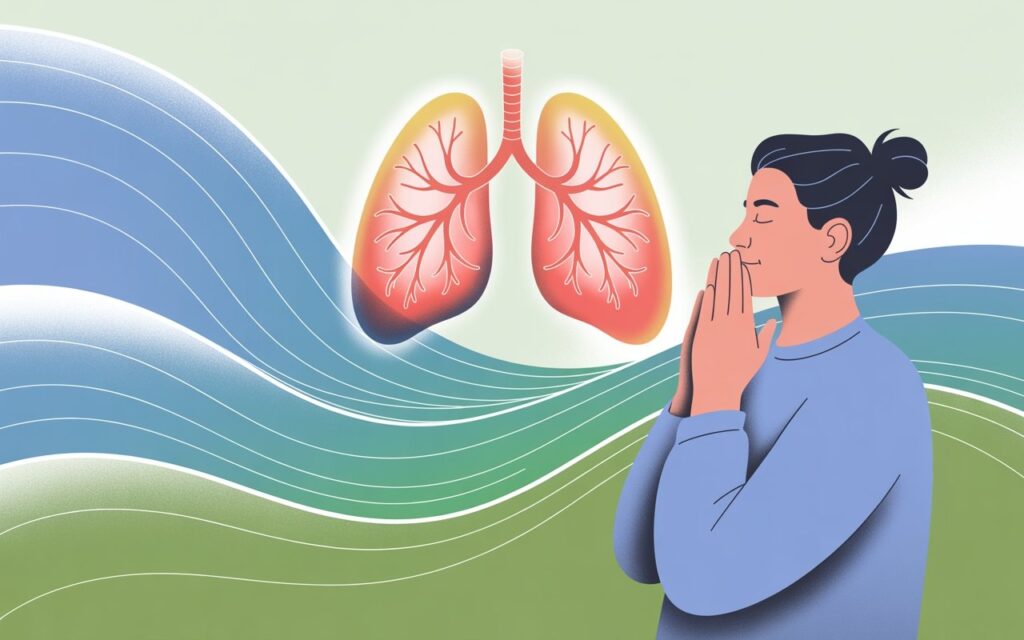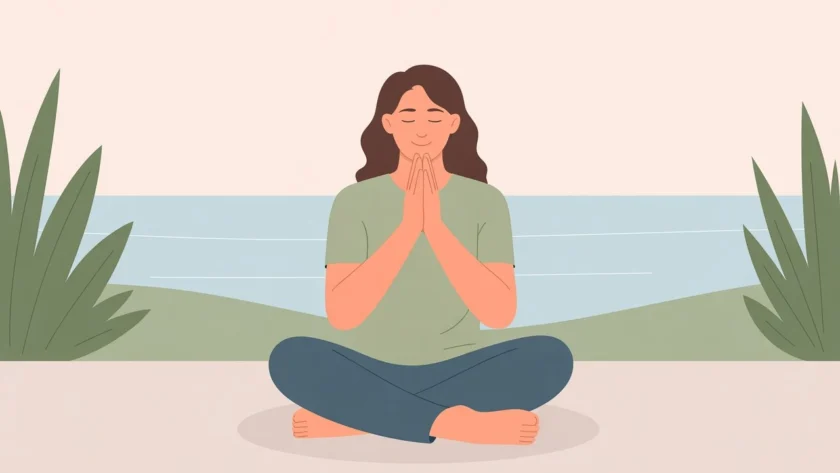I’ll never forget the first time a panic attack hit me in the middle of Target. My chest tightened, my vision narrowed, and I genuinely thought I was having a heart attack right there in the cereal aisle. My therapist later asked me a question that seemed almost too simple: “Were you breathing?” Honestly, I couldn’t remember. That’s when I learned something that changed everything—when anxiety takes over, our breath is often the first thing we lose control of, and ironically, it’s also our fastest path back to peace.
Here’s what I’ve come to understand after years of working with anxious hearts and my own struggles: God gave us an incredibly powerful tool that’s always with us, costs nothing, and can interrupt anxiety’s grip in minutes. Your breath. It sounds almost too simple, right? But there’s profound wisdom in how our Creator designed the connection between our breathing and our nervous system. When we learn to work with our breath intentionally, we’re not just managing symptoms—we’re partnering with the way God made our bodies to find calm.
Why Breathing Exercises Actually Work for Anxiety
Before I share the specific techniques that have helped me and countless others, let’s talk about what’s happening in your body when anxiety strikes. I think understanding this makes the practices so much more powerful.
When you’re anxious, your sympathetic nervous system kicks into high gear—it’s that fight-or-flight response you’ve probably heard about. Your heart races, your breathing becomes shallow and rapid, and your body floods with stress hormones. It’s like your internal alarm system got triggered, even though there’s no actual emergency in the Target cereal aisle or wherever anxiety finds you.
Here’s the beautiful thing: deliberate, controlled breathing activates your parasympathetic nervous system—the part that tells your body, “Hey, we’re actually safe here.” It’s like flipping a biological switch from panic mode to peace mode. I love how God designed us with this built-in reset button. Psalm 46:10 tells us to “Be still, and know that I am God,” and sometimes that stillness starts with simply learning to breathe again.
In my experience, breathing exercises for anxiety relief work because they give your racing mind something concrete to focus on. Instead of spiraling into worst-case scenarios, you’re counting breaths, focusing on the sensation of air moving in and out, and gently anchoring yourself back to the present moment.

Diaphragmatic Breathing: Your Foundation for Calm
Let me share the technique that’s been my go-to for years now. Diaphragmatic breathing—sometimes called belly breathing—is probably the most powerful breathing exercise I’ve learned. I practice this every single morning with my coffee, even on days when anxiety isn’t knocking at my door. Think of it as preventive maintenance for your nervous system.
Here’s how to do it, and I promise it’s simpler than it sounds:
Getting Started: Find a comfortable position. You can sit in a chair with your feet flat on the floor, lie down, or even stand if that’s all you’ve got in the moment. Place one hand on your chest and the other on your belly, just below your ribcage. This hand placement helps you feel what’s happening—it turns the exercise from abstract to tangible.
The Practice: Breathe in slowly through your nose for a count of four, letting your belly expand like a balloon filling with air. The hand on your chest should stay relatively still while the hand on your belly rises. This is important because when we’re anxious, we tend to breathe shallowly into our chest, which actually signals more stress to our nervous system.
Hold that breath gently for a count of two—not forcing anything, just pausing naturally. Then exhale slowly through your mouth for a count of six, feeling your belly deflate as the air leaves. That longer exhale is key for activating your calming response.
Repeat this cycle for five to ten minutes, or even just three minutes if that’s all you have. I’ve found that consistency matters more than duration. Five minutes of daily practice will serve you better than a random thirty-minute session once a month.
Why This Works: Diaphragmatic breathing forces you to engage the diaphragm muscle, which sits right below your lungs. When you breathe this way, you’re taking in more oxygen and triggering a cascade of calming signals throughout your body. It’s not magic—it’s biology working exactly as God designed it.
I remember practicing this in my car before meetings that made me anxious, in bathroom stalls when social situations overwhelmed me, and countless times at 3 AM when worry wouldn’t let me sleep. It doesn’t always make the anxiety disappear instantly, but it consistently brings the volume down from a scream to a whisper.
Box Breathing: Structure for Scattered Thoughts
When my anxiety is particularly high and my thoughts are bouncing around like a pinball machine, I reach for box breathing. There’s something about the equal counts and simple structure that my anxious brain finds incredibly soothing. This technique comes from Navy SEALs, who use it to stay calm in genuinely dangerous situations. If it works for them, it can certainly help us through our daily challenges.
How to Practice Box Breathing: Picture a box or square in your mind—each side represents a phase of your breathing. Start by exhaling completely, emptying your lungs. Then:
- Breathe in through your nose for a count of four (first side of the box)
- Hold your breath for a count of four (second side)
- Exhale through your mouth for a count of four (third side)
- Hold empty for a count of four (fourth side)
Then repeat the cycle. I usually do this for about five minutes, though even a few rounds can help when you’re in a tight spot.
The beauty of box breathing is that it gives your scattered mind a clear structure to follow. Instead of trying to wrestle your anxious thoughts into submission—which never works, by the way—you’re simply counting and breathing. Your mind has a job that doesn’t involve catastrophizing about the future or replaying past embarrassments.
I’ve used this technique in waiting rooms before doctor’s appointments, during tough conversations when I needed to stay calm, and even while sitting in traffic when I could feel frustration morphing into anxiety. The predictable rhythm creates a sense of control when everything else feels chaotic.
Alternate Nostril Breathing: Ancient Wisdom for Modern Anxiety
Now, I’ll be honest—when I first heard about alternate nostril breathing, I thought it sounded a bit out there. But I’ve learned that some ancient practices carry wisdom that our modern world desperately needs. This technique comes from yogic traditions and has been used for thousands of years to calm the mind and balance the nervous system.
The Practice: Sit comfortably and use your right thumb to gently close your right nostril. Inhale slowly and deeply through your left nostril for a count of four. At the top of your inhale, close your left nostril with your right ring finger, release your thumb from your right nostril, and exhale through the right side for a count of four.
Now inhale through that same right nostril for four counts, then close it with your thumb, release your ring finger from the left nostril, and exhale through the left side. That’s one complete cycle. Continue this pattern for five to ten minutes, or as long as feels comfortable.
Why I Love This One: There’s something deeply centering about the focused attention this practice requires. You can’t think about your to-do list or replay that awkward conversation from yesterday when you’re concentrating on which nostril you’re breathing through. It’s almost meditative in how it anchors you to the present moment.
I find this particularly helpful for anxiety that comes with racing thoughts. The alternating pattern seems to create balance—not just in your breathing, but in your whole mental state. Some mornings, I’ll do this practice while praying, using each breath as a reminder of God’s presence. Inhale His peace, exhale your worry. It’s a physical prayer, really.
The 4-7-8 Technique: Your Natural Sleep Aid
Let me tell you about the breathing exercise that’s been a game-changer for my nighttime anxiety. I used to lie awake for hours, my mind spinning through every possible thing that could go wrong tomorrow, next week, or ten years from now. The 4-7-8 technique, developed by Dr. Andrew Weil, has become my go-to for those restless nights when anxiety is trying to steal my sleep.
How It Works: Start by exhaling completely through your mouth, making a whoosh sound. Close your mouth and inhale quietly through your nose for a count of four. Hold your breath for a count of seven. Then exhale completely through your mouth for a count of eight, making that whoosh sound again. That’s one breath cycle. Do this four times in a row.
The beauty of this particular ratio—4-7-8—is that it really emphasizes that long exhale, which is where the magic happens for calming your nervous system. Dr. Weil calls it a “natural tranquilizer for the nervous system,” and I’ve found that description to be accurate.
When to Use It: I practice this every night before bed, but it’s also incredibly helpful during the day when anxiety hits hard. I’ve done it in my car before going into stressful situations, during my lunch break to reset from a difficult morning, and even sitting at my desk when work stress threatens to overwhelm me.
What I appreciate most about the 4-7-8 technique is how quickly it works. Within a few cycles, I can usually feel my shoulders dropping, my jaw unclenching, and that tight feeling in my chest starting to ease. It’s not that the circumstances causing my anxiety change—it’s that my body’s response to them does.
Making Breathing Exercises Part of Your Daily Rhythm
Here’s what I’ve learned about these breathing exercises for anxiety relief: they work best when you practice them regularly, not just when you’re in crisis mode. Think of it like building a muscle. You wouldn’t wait until you needed to lift something heavy to start strength training, right?
I start every morning with five minutes of diaphragmatic breathing while I’m having my coffee. It’s become as much a part of my routine as brushing my teeth. This daily practice means that when anxiety does show up—and it still does sometimes—my body already knows what to do. The pathway to calm is well-worn and familiar.
Creating Your Practice: Start small. Don’t try to master all these techniques at once or pressure yourself to practice for thirty minutes a day. Pick one technique that resonates with you and commit to just five minutes daily. Set a reminder on your phone, pair it with an existing habit, or do it at the same time each day.
I also keep a small journal where I note how I’m feeling before and after my breathing practice. Not in an obsessive way—just a quick check-in. This has helped me see patterns and recognize how consistently these simple exercises shift my emotional and physical state.
Breathing as Prayer: The Spiritual Dimension
You know what’s beautiful? These breathing exercises can become a form of prayer. I often use my breath as a physical expression of my dependence on God. With each inhale, I’m consciously receiving His peace, His presence, His provision. With each exhale, I’m releasing my worries, my need for control, my anxious thoughts into His capable hands.
Philippians 4:6-7 tells us, “Do not be anxious about anything, but in every situation, by prayer and petition, with thanksgiving, present your requests to God. And the peace of God, which transcends all understanding, will guard your hearts and your minds in Christ Jesus.” Sometimes our prayers don’t need eloquent words—sometimes they can be as simple and profound as intentional breathing, coupled with an open heart toward God.
I’ll pray silently as I breathe: “Lord, I receive Your peace” on the inhale, and “I release this fear to You” on the exhale. This transforms a physiological exercise into a spiritual practice, engaging both body and soul in the process of finding peace.
When to Use Each Technique
Different situations call for different approaches, and I’ve found that having a variety of breathing exercises in my toolbox helps me respond to anxiety more effectively. Here’s how I typically choose:
For general daily practice and prevention: Diaphragmatic breathing is my foundation. It’s simple enough to do anywhere and effective enough to make a real difference.
For acute anxiety or panic: Box breathing gives me structure when my thoughts are completely scattered. The equal counts and clear pattern help me regain a sense of control.
For racing thoughts and mental chatter: Alternate nostril breathing demands enough focus that it interrupts the thought spiral. It’s almost impossible to catastrophize about the future when you’re concentrating on which nostril you’re breathing through.
For bedtime or when you need quick calm: The 4-7-8 technique is my go-to. It’s especially powerful for winding down at night or when I need to calm down relatively quickly.
Your Breath, Your Anchor
I wish I could tell you that these breathing exercises will eliminate your anxiety forever. That wouldn’t be honest, and you deserve honesty. What I can tell you is that these simple techniques have given me—and can give you—a tangible tool to manage anxiety when it shows up. They’ve helped me reclaim moments that anxiety tried to steal. They’ve brought me back from the edge of panic more times than I can count.
Your breath is always with you. In the middle of Target, in the 3 AM darkness, in the waiting room, in the middle of that difficult conversation—your breath is there, ready to be your anchor back to peace. God designed your body with this incredible built-in mechanism for finding calm, and learning to use it intentionally is one of the most practical forms of self-care you can practice.
Start today. Pick one technique from this article and try it right now. Set a timer for five minutes, close your eyes if you’re comfortable doing so, and just breathe. Notice what happens. Notice how your body responds. Notice the small shift from chaos to calm, from panic to peace.
Remember, healing and growth rarely happen overnight. They happen breath by breath, moment by moment, day by day. Be patient with yourself. Extend the same grace to yourself that God extends to you—which is infinite and unconditional.
You’ve got this. And more importantly, you’ve got Him, breathing life into you with every single breath. That’s not just poetry—it’s the beautiful, practical reality of how God meets us in our anxiety, one breath at a time.Retry




